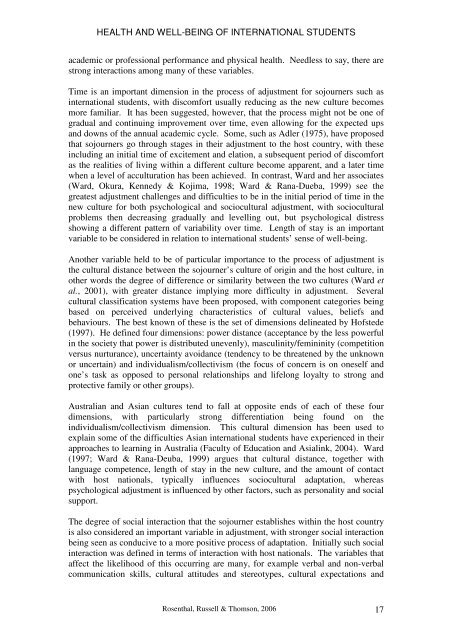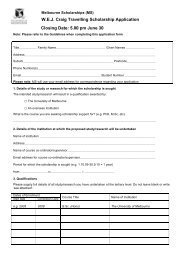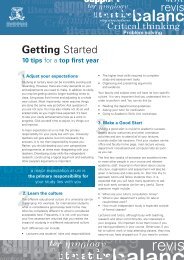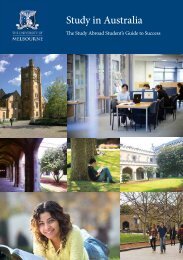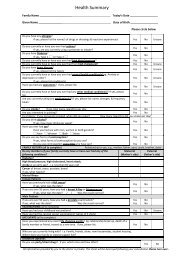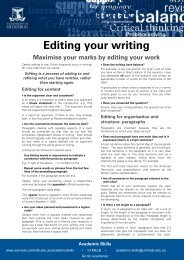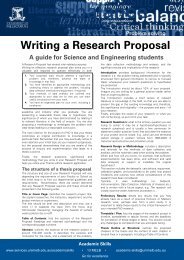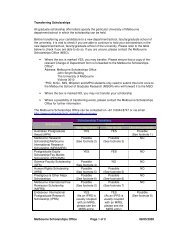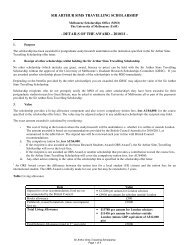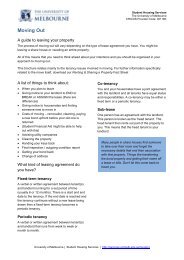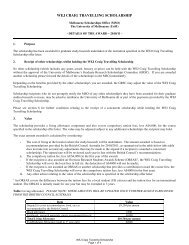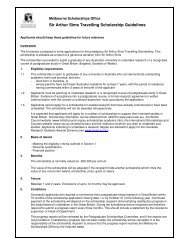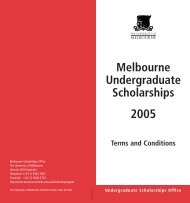a growing experience - Student Services - University of Melbourne
a growing experience - Student Services - University of Melbourne
a growing experience - Student Services - University of Melbourne
Create successful ePaper yourself
Turn your PDF publications into a flip-book with our unique Google optimized e-Paper software.
HEALTH AND WELL-BEING OF INTERNATIONAL STUDENTSacademic or pr<strong>of</strong>essional performance and physical health. Needless to say, there arestrong interactions among many <strong>of</strong> these variables.Time is an important dimension in the process <strong>of</strong> adjustment for sojourners such asinternational students, with discomfort usually reducing as the new culture becomesmore familiar. It has been suggested, however, that the process might not be one <strong>of</strong>gradual and continuing improvement over time, even allowing for the expected upsand downs <strong>of</strong> the annual academic cycle. Some, such as Adler (1975), have proposedthat sojourners go through stages in their adjustment to the host country, with theseincluding an initial time <strong>of</strong> excitement and elation, a subsequent period <strong>of</strong> discomfortas the realities <strong>of</strong> living within a different culture become apparent, and a later timewhen a level <strong>of</strong> acculturation has been achieved. In contrast, Ward and her associates(Ward, Okura, Kennedy & Kojima, 1998; Ward & Rana-Dueba, 1999) see thegreatest adjustment challenges and difficulties to be in the initial period <strong>of</strong> time in thenew culture for both psychological and sociocultural adjustment, with socioculturalproblems then decreasing gradually and levelling out, but psychological distressshowing a different pattern <strong>of</strong> variability over time. Length <strong>of</strong> stay is an importantvariable to be considered in relation to international students’ sense <strong>of</strong> well-being.Another variable held to be <strong>of</strong> particular importance to the process <strong>of</strong> adjustment isthe cultural distance between the sojourner’s culture <strong>of</strong> origin and the host culture, inother words the degree <strong>of</strong> difference or similarity between the two cultures (Ward etal., 2001), with greater distance implying more difficulty in adjustment. Severalcultural classification systems have been proposed, with component categories beingbased on perceived underlying characteristics <strong>of</strong> cultural values, beliefs andbehaviours. The best known <strong>of</strong> these is the set <strong>of</strong> dimensions delineated by H<strong>of</strong>stede(1997). He defined four dimensions: power distance (acceptance by the less powerfulin the society that power is distributed unevenly), masculinity/femininity (competitionversus nurturance), uncertainty avoidance (tendency to be threatened by the unknownor uncertain) and individualism/collectivism (the focus <strong>of</strong> concern is on oneself andone’s task as opposed to personal relationships and lifelong loyalty to strong andprotective family or other groups).Australian and Asian cultures tend to fall at opposite ends <strong>of</strong> each <strong>of</strong> these fourdimensions, with particularly strong differentiation being found on theindividualism/collectivism dimension. This cultural dimension has been used toexplain some <strong>of</strong> the difficulties Asian international students have <strong>experience</strong>d in theirapproaches to learning in Australia (Faculty <strong>of</strong> Education and Asialink, 2004). Ward(1997; Ward & Rana-Deuba, 1999) argues that cultural distance, together withlanguage competence, length <strong>of</strong> stay in the new culture, and the amount <strong>of</strong> contactwith host nationals, typically influences sociocultural adaptation, whereaspsychological adjustment is influenced by other factors, such as personality and socialsupport.The degree <strong>of</strong> social interaction that the sojourner establishes within the host countryis also considered an important variable in adjustment, with stronger social interactionbeing seen as conducive to a more positive process <strong>of</strong> adaptation. Initially such socialinteraction was defined in terms <strong>of</strong> interaction with host nationals. The variables thataffect the likelihood <strong>of</strong> this occurring are many, for example verbal and non-verbalcommunication skills, cultural attitudes and stereotypes, cultural expectations andRosenthal, Russell & Thomson, 2006 17


